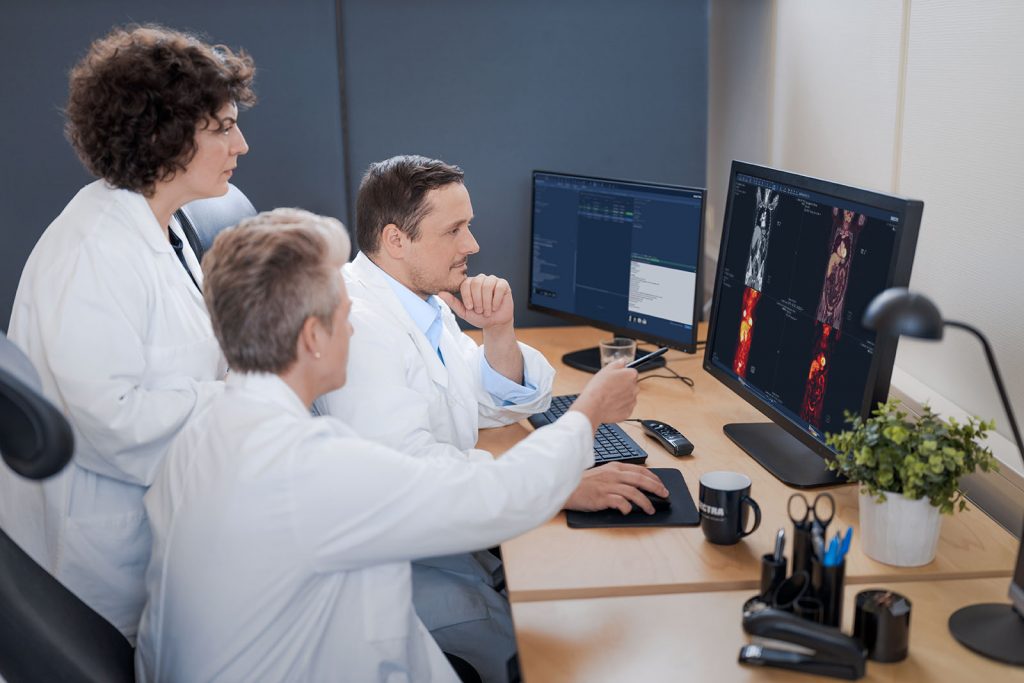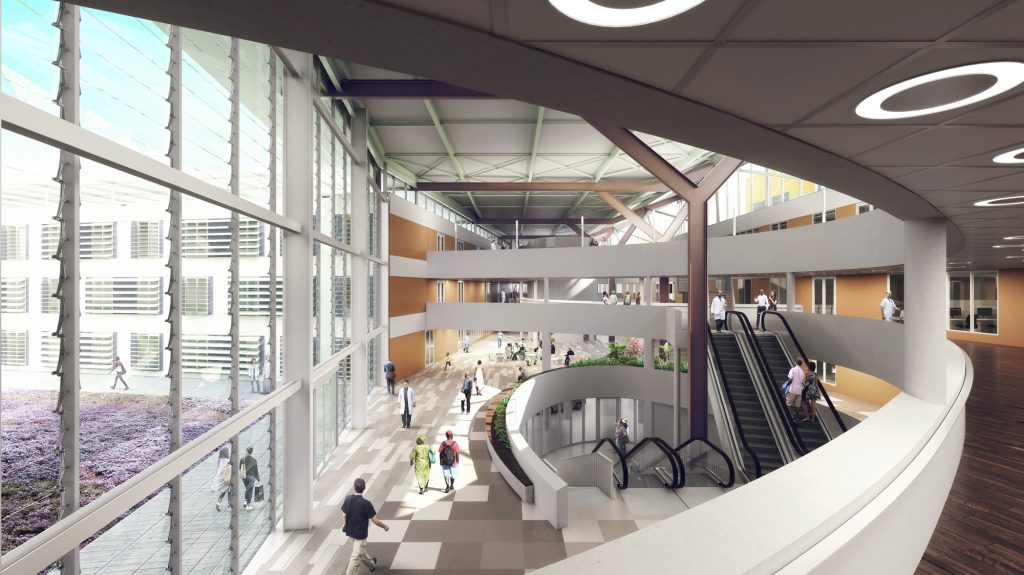The Curaçao Medical Center (CMC) Willemstad opened its doors in November 2019. The new, ultramodern hospital was equipped with the latest technology, making it the most innovative in the region. Efficient diagnostics and having all the right tools to prepare for multidisciplinary meetings were imperative for the hospital as it moved forward. The CMC, therefore, chose Sectra’s enterprise imaging solution not only for its advanced technical capabilities, but also because Sectra’s knowledge and experience would help prepare the CMC for the future.
Sectra has always been a very important and reliable partner for us. The technology they provide is stable, and the people who work there are very supportive. They have a lot of knowledge and experience, and that was especially helpful for this project.
The project started when the hospital moved from the Sint-Elisabeth Hospitaal, which had been using Sectra PACS for many years, to a brand-new building. Before the move, the hospital was also using a second PACS in addition to the Sectra PACS that could not be connected. According to IT Manager Elmer Kwidama, this posed a problem.
“At the old hospital, we were severely limited by financial problems. We had wanted to work with one PACS for a long time. We also wanted to make images from other medical specialties available through the EMR. Unfortunately, this did not work out at the time. It was technically too complex and very expensive,” Kwidama explains.
With the construction of the new hospital, an opportunity arose, says Systems Integration Coordinator and PACS Administrator Gianni Sille: “We had to start over on numerous fronts. This project was able to capitalize on that nicely.”
Sectra was the obvious choice for the CMC when it came to setting up its enterprise imaging environment. “Sectra has always been a very important and reliable partner for us. The technology they provide is stable, and the people who work there are very supportive. They have a lot of knowledge and experience, and that was especially helpful for this project.”
Identifying needs and preferences
It was clear, however, that the focus should not be on the technical aspects, but on the demands of the medical specialists. Kwidama explains: “We organized several sessions with all medical specialists to discuss their hard and fast requirements for medical imaging and reporting. Sectra took part in these meetings and was able to immediately translate their requirements into technological solutions. As a result, we instantly gained a clear understanding of what would be possible and what would not.”

Two issues were central to these discussions: how the image storage would be arranged and what system would be used for reporting. “We store the images ourselves on our own servers, and we use the cloud to share images with other hospitals through Sectra’s Image Exchange Portal (IEP). We provide the images so the other hospital can then retrieve them from the portal. This is completely independent of the PACS or VNA that the other hospital uses,” Sille explains.
We are simply seeing more multidisciplinary meetings across departments since we started working with the Sectra enterprise imaging system. These consultations are much better facilitated now since all images can be viewed from one system. On top of that, our diagnostic workflow is much more efficient.
Roughly 5,000 images per year are shared in this way with other hospitals or diagnostic centers, and IEP is also used when the CMC outsources diagnostics. “We work closely with a teleradiology company in the Netherlands. They take over diagnostics when we are short of capacity, and we can also consult with them if we are uncertain about anything. It’s great that through a link with Sectra, the teleradiology company can access the images directly on their screen, so there is no delay,” tells Sille.
When it comes to reporting, there are two options: the report is either made in the EMR or through Sectra. Sille explains how it works: “Most departments are able to use the EMR. They create the report directly in the EMR and view the images in the Sectra UniView viewer. However, interventional cardiology and radiology specialists have more requirements. For them, it is much easier to create the report directly through Sectra since that gives access to more functionalities.”
Technical implementation in one month
When the CMC went live, it was a resounding success. Most specialties began using the solution immediately, including cardiology, interventional cardiology, gynecology, ophthalmology, orthopaedics, gastroenterology, pulmonology, and neurology. Other specialties are still waiting.
“ENT, dermatology and plastic surgery will have to wait to go live. And in the longer term, oncology is still in the pipeline. Nevertheless, we are very happy that so many specialties were able to go live immediately in 2019,” says Kwidama.
We did the technical implementation in just one month thanks to proper planning, in which Sectra was closely involved. We had a clear understanding of the systems we needed to link and how to make the necessary connections.
Sille explains that the entire process went quite smoothly. “We did the technical implementation in just one month thanks to proper planning, in which Sectra was closely involved. We had a clear understanding of the systems we needed to link and how to make the necessary connections. There was only one real setback involving a device used in interventional radiology. The intervention room in the new hospital was not ready yet, so we were forced to use the old intervention room. Therefore, the Sectra system had to be connected to the old room, but that room didn’t have any cables. So, we installed a fiber connection to link the two together. That did cause some headaches, but it worked.”
Fast adoption by medical specialists
Something else that went very smoothly was adjusting to the new way of working. Medical specialists and support staff had a positive reaction from day one. According to Kwidama, this was a result of the hospital’s relocation as well as the Sectra solution.
Everything was new: the building, much of the equipment. It was the perfect time to switch to a new way of storing images and reporting. In addition, the Sectra system is very user-friendly. It’s very straightforward. We hardly got any questions at all, just positive feedback. Reading images from other hospitals in the region was the only downside. “Those hospitals are not as modern and often cannot upload images to the portal. We get all kinds of file formats sent in all sorts of ways. It can take a while to import those sometimes.”
Collaboration with other hospitals
Because the CMC has an agreement in place with the hospitals in Aruba, Bonaire, and Sint Maarten to work closely together and become the leading hospital group in the region, Kwidama feels a responsibility to help those hospitals move forward as well. “Of course, I can’t decide for them. I can only say that the CMC is very satisfied with Sectra and that there are often more technical possibilities than they may think of themselves.”

In addition to its leading role in the region, the CMC is also attracting more and more foreign patients. There is even a separate unit set up for that purpose: the International Patient Care Unit. These can be patients from the US who realize they can get a high standard of healthcare cheaper in Curaçao, but also patients from Central and South America who cannot get the same quality care in their own country. The unit also treats tourists who are visiting the island.
“Sometimes cruise ships even change their course because there is a sick patient on board who urgently needs specialized medical care,” Kwidama explains. Hospital’s mission is to collaborate with other organizations on the island and in the region that want to provide quality care but are not yet equipped with the proper infrastructure and technology. “We are still investigating how we can improve this collaboration while also respecting patient privacy.”
More multidisciplinary meetings, faster diagnostics
Of course, one can wonder what patients have to gain from an investment in enterprise imaging. The answer is a lot, according to Sille. “We are simply seeing more multidisciplinary meetings across departments since we started working with the Sectra enterprise imaging system.
These consultations are much better facilitated now since all images can be viewed from one system. On top of that, our diagnostic workflow is much more efficient. As soon as an image is taken, the physician has access to it. If they have doubts and want to consult with a colleague or our Dutch diagnostic partner, they can do so immediately. They can then both look at the same image from their own workstations and point out specific things they want to discuss.
This has all become much easier and faster than in the past.It has also become easier for research physicians to conduct research based on the images, because you can easily anonymize data.”
Suggestions for other hospitals
Kwidama and Sille have three pieces of advice for other hospitals considering a switch to an enterprise imaging system.
1. “Organize sessions with the medical specialists beforehand so you have a clear understanding of their wishes and requirements. That way, you can create a workflow that fits their needs. In our case, for example, the orthopaedists had specific requirements that we could fulfill with Sectra’s orthopaedic package, while other specialties did just fine with the Sectra UniViewer that is integrated into the EMR,” Kwidama says.
2. Another piece of advice is to think in terms of solutions rather than problems. “Our ophthalmologists joined us later. They use a lot of very specific imaging technology. You might think that would be a challenge, but it turned out that Sectra has a lot of experience in this area. Ophthalmology, for example, produces very high resolution images that are far too large to be imported into the EMR. However, their equipment can also create a PDF file. We now view these in the Sectra environment, while the raw data remains on the device’s server. For multidisciplinary meetings and patient consultations, the PDF is sufficient in almost all cases. The high resolution images are only of interest to the ophthalmologists, who can view them on their specialized computers. In retrospect, ophthalmology was probably the easiest to connect to the Sectra enterprise imaging solution,” says Sille.
3. A final piece of advice is, don’t just focus on the features and benefits of the system when selecting a vendor. Ultimately, the service you get from your imaging IT partner really is the most important thing. Kwidama explains: “We chose Sectra purely because we knew from our previous collaboration that it is a very reliable partner that is involved every step of the way. They have knowledge and expertise we don’t have and also don’t need. Technically, the systems from different suppliers are quite similar. The difference is the additional service. All I can say is, make use of the knowledge Sectra has. Don’t try to reinvent the wheel. Use the experience they’ve gained at other hospitals. We have been able to gain a lot of momentum as a result.”
Featured products & services
Related cases





